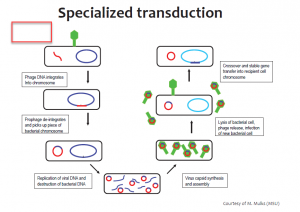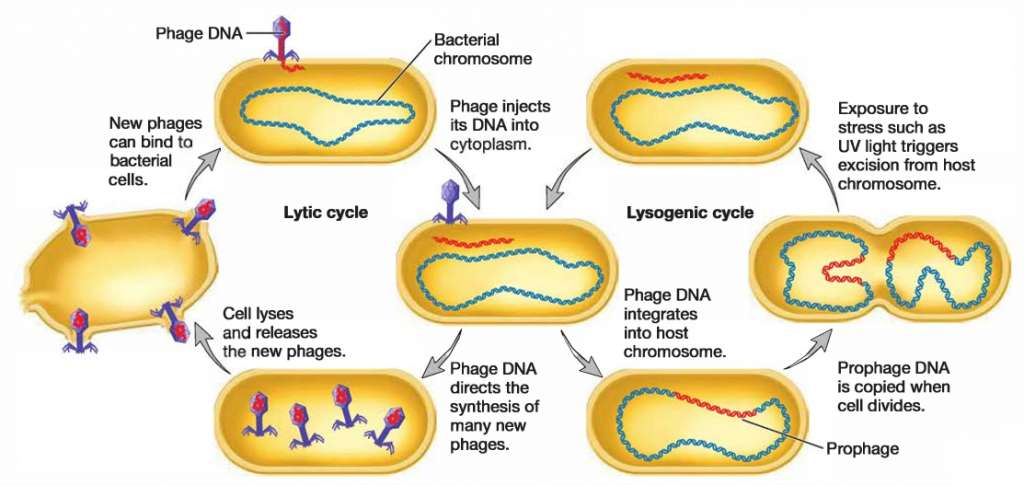In transduction, DNA is transferred from one cell to another by viruses. Genetic transfer of host genes by bacteriophages occurs in two ways: generalized transduction and specialized transduction. Specialized transduction occurs only in some temperate phages. But specialized transduction is an extremely efficient gene transfer mechanism.
On some occasions, DNA from a specific region of the host chromosome integrates directly into the virus genome, usually replacing some viral genes. The resulting transducing defective phage particles (temperate phage) now have bacterial DNA as part of the genome. To understand the process of specialized transduction by temperate phage, you must first understand the lytic cycle of bacteriophage.
1. When a bacterial cell is lysogenic by a lambda phage, the phage genome integrates into the host DNA at a specific site.
2. Viral DNA replicates under host control
3. In induction: viral DNA is separated from host DNA by a reverse process of integration.
- During the normal event: Lambda’s DNA is cleaved as a unit
- During the rare event. incorrectly excised lambda phage; some of the adjacent bacterial genes are also excised along with the phage DNA, while some of the phage DNA is left behind. These phages are called defective lambda phages.
- When lysate containing defective lambda phage is mixed with a sensitive bacterial population, there are two possibilities:
1. Bacterial DNA can integrate into the host chromosome during lysogenization and
2. DNA can replicate in recipients as part of lytic infection.
Transduction has been found to occur in a variety of bacterial populations including:
- Escherichia coli
- Pseudomonas spp.
- Salmonella spp.
- Staphylococcus spp.

Summary
Infection with a moderate phage can cause bacterial cell death, but sometimes these phages integrate into the bacterial chromosome, offering the possibility of a longer-lasting relationship. Here we define three main ecological and evolutionary benefits of temperate phage to bacteria: as agents of horizontal gene transfer (HGT), as sources of genetic variation for evolutionary innovation, and as weapons of bacterial competition. We suggest that a coevolutionary perspective is required to understand the roles of temperate phages in bacterial populations.
What is Specialized Transduction?
Temperate bacteriophages display lysogenic life cycles. They are involved in a specialized transduction process in which a piece of bacterial DNA is transferred from one bacterium to another due to a mistake. Therefore, specialized transduction can be defined as the transfer of donor bacterial DNA to another bacterium by temperate bacteriophages. When temperate phages infect bacteria, they can integrate viral DNA into the bacterial chromosome and remain in the prophage stage for several bacterial generations without releasing it from the bacterial genome.
During the replication of the bacterial genome, the viral DNA is subject to replication and enters new bacterial cells and survives. However, when the prophages are induced by certain factors, the viral DNA separates from the bacterial chromosome. Sometimes during this detachment, fragments of bacterial chromosomes break off and remain attached to the DNA of the prophage. Due to induction, the phages undergo a lytic cycle afterwards. The viral genome replicates with attached bacterial DNA and packages into new capsids and produces new phages. New phages release the bacterial cell by lysis. When a new phage infects another bacterium, the bacterial DNA is transferred to it.

